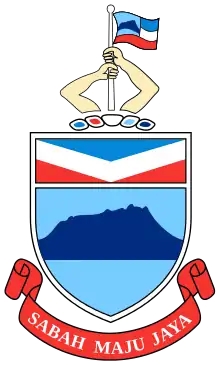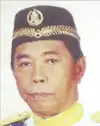Yang di-Pertua Negeri of Sabah
The Governor of Sabah (Yang di-Pertua Negeri) is the ceremonial head of state of the Malaysian state of Sabah. The Yang di-Pertua Negeri is styled Tuan Yang Terutama (TYT; "His Excellency").
| Yang di-Pertua Negeri Sabah Governor of Sabah | |
|---|---|
 | |
 | |
| Style | Tuan Yang Terutama (His Excellency) |
| Status | Head of State |
| Residence | Istana Seri Kinabalu, Peti Surat 10093, 88500 Kota Kinabalu[1] |
| Appointer | Yang di-Pertuan Agong |
| Term length | 4 Years (At the Yang di-Pertuan Agong Pleasure) |
| Inaugural holder | Mustapha Harun |
| Formation | 16 September 1963 |
The current officeholder is Juhar Mahiruddin, who was sworn in on 1 January 2011.
Appointment
The office of the Yang di-Pertua Negeri (governor) is established by the Constitution of Sabah. According to Article 1 (1) of the Constitution, the office must exist and be appointed by the Yang di-Pertuan Agong (King) after consultation with the chief minister.[2] Every governor is appointed for a term of four years. However, the king reserves the power to extend his term of appointment.
The governor has neither a deputy nor assistant. However, in event of his inability to govern the state due to illness, absence or any other cause, the king reserves the power to appoint a person to exercise the function of the governor.
Functions, powers and privileges
Many functions and powers of the king – at the federal level – are delegated to the governor at the state level – like the other rulers of states. The governor, however, has no power and function towards the judiciary.
As he is the head of state, he is a member of the Conference of Rulers. He share the same power with the other members of the conference. However, he cannot be appointed as the Yang di-Pertuan Agong.
Article 10 of the Constitution describes that the governor has to act according to the Constitution and makes decisions based on the advice from the state cabinet. However, he may also act on his own discretion in certain matters.[3]
The Constitution provides the power to the governor to appoint key officers of the state. Most of them are appointed after consultation with the chief minister, except in appointing the chief minister.[4] The same process occurred during dismissal of an officeholder.
The Constitution also describes powers of the governor in the state legislative assembly. All bills must be assented by the governor in 30 days after a bill passed. The governor also has to address the assembly annually.
List of Yang di-Pertua Negeri
The following is the list of Yang di-Pertua Negeri of Sabah:[2][5]
| No. | Coat of Arms | Portrait | Yang di-Pertua Negeri | Term of office | ||
|---|---|---|---|---|---|---|
| Took office | Left office | Days | ||||
| 1 | .svg.png.webp) |
 |
Mustapha Harun | 16 September 1963 | 16 September 1965 | 2 years, 0 days |
| 2 | .svg.png.webp) |
 |
Pengiran Ahmad Raffae | 16 September 1965 | 16 September 1973 | 8 years, 0 days |
| 3 | .svg.png.webp) |
 |
Fuad Stephens | 16 September 1973 | 28 July 1975 | 1 year, 315 days |
| 4 | .svg.png.webp) |
 |
Mohd Hamdan Abdullah | 28 July 1975 | 10 October 1977 | 2 years, 74 days |
| 5 | .svg.png.webp) |
 |
Ahmad Koroh | 12 October 1977 | 25 June 1978 | 256 days |
| 6 | .svg.png.webp) |
 |
Mohamad Adnan Robert | 25 June 1978 | 31 December 1986 | 8 years, 189 days |
| 7 | .svg.png.webp) |
 |
Mohammad Said Keruak | 1 January 1987 | 31 December 1994 | 7 years, 364 days |
| 8 |  |
 |
Sakaran Dandai | 1 January 1995 | 31 December 2002 | 7 years, 364 days |
| 9 |  |
 |
Ahmadshah Abdullah | 1 January 2003 | 31 December 2010 | 7 years, 364 days |
| 10 |  |
Juhar Mahiruddin | 1 January 2011 | Incumbent | 12 years, 298 days | |
Living former Yang di-Pertua Negeri
One former Yang di-Pertua Negeri of Sabah is alive.
| Name | Term as Yang di-Pertua Negeri | Date of birth |
|---|---|---|
| Ahmadshah Abdullah | 2003–2010 | 9 December 1946 |
The most recent death of a former Yang di-Pertua Negeri was that of Sakaran Dandai (1995–2002).
See also
- Yang di-Pertua Negeri
- Governor of North Borneo (for the Governors of the predecessing Colony of North Borneo)
References
- "Istana Negeri".
- "Yang di-Pertua Negeri". Sabah Government. Retrieved 17 June 2016.
- "Constitution of the State of Sabah: Part 1" (PDF). Attorney-General's Chamber of the State of Sabah. Retrieved 1 October 2013.
- Previously, the Chief Minister is appointed after consultation with the Federal Prime Minister.
- "Mantan Tuan Yang Terutama Yang di-Pertua Negeri Sabah". Sabah Government. Retrieved 13 April 2011.
External links
- Yang di-Pertua Negeri at the Sabah Government official website
- Istana Negeri Kota Kinabalu official website
